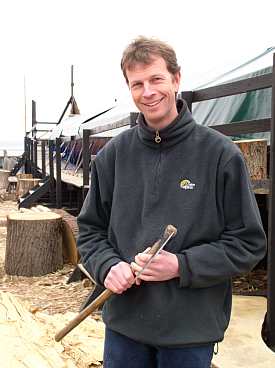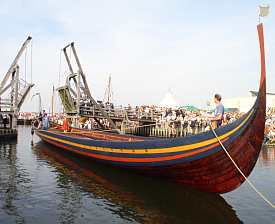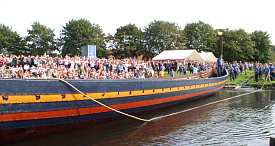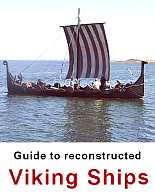|

Søren
Nielsen, master shipbuilder in front of the Sea Stallion from
Glendalough before it was fully finished. Photo:
Michael Borgen
|
It appears rather
like a maritime version of the biblical tale of Jesus’ feeding in
the desert: you take some pieces of old, mouldy wood, and from that,
you create a seagoing vessel for almost 100 warriors. In
year 2000 the task was placed in the hands of master shipbuilder
Søren Nielsen, and now the mission is completed. The Sea Stallion
from Glendalough is nearly finished and will later set sail for
Dublin, Ireland, where the original Viking ship was built 958 years
ago. The
remains of the original ship lies in the Viking
Ship Museum a few hundred meters from the shipyard in Roskilde.
Many tourists have been disappointed when they saw how little was
actually left of the largest warship in the collection - the Skuldelev
2. A few unimpressive bits of wood lie at the bottom of a large
metal frame, to illustrate the impressive size of the real warship. But
to the leader of the Viking Ship Museum’s shipyard, it is exactly
the right bits that have survived. Exactly the ones that are required
to make a reconstruction possible.
|

The
Sea Stallion on its way out of the harbour of Roskilde. Søren
Nielsen standing in the ship to the right. Photo:
Michael Borgen
|
- We have almost
the entire keel, and we know the distance between the ribs. We also
have most of the stern, so we can practically figure out what the ship
looked like, says Søren Nielsen. -
But we do not claim to have made a 100% exact replica of the original
Skuldelev 2 Viking ship . The ship is our bid, based on available
data. Building
prolonged
Søren Nielsen is justifyably proud of launching the world’s largest
reconstructed Viking ship, but the launching also contains a drop of
melancholy - it marks the end of his and his team’s task. For four
years, they have attempted to copy the way in which the Vikings made
ships.
|

The
30 meter long Sea
Stallion touching the sea for the first time in september 2004
after being named by Queen Margrethe outside the Viking Ship
Museum. Photo:
Michael Borgen
|
Søren Nielsen is
justifyably proud of launching the world’s largest reconstructed
Viking ship, but the launching also contains a drop of melancholy - it
marks the end of his and his team’s task. For four years, they have
attempted to copy the way in which the Vikings made ships. -
Our task wasn’t to build a Viking ship as fast as possible. First
and foremost, we have gathered experience on the methods used. Quite
consciously, we have prolonged the process for four years, because we
wanted to experiment and record everything we did. Even
minor details in the very technique employed have been pondered upon
and tried out. Thus, at one point it was necessary to send four
shipbuilders to Norway for two weeks to learn the correct way to use
the axe for a particular cut. Noone in Denmark
had the necessary experience in this very special axe-technique (see
the article Artful Axework
ed.). Viking
ships were strong
With a rope tied around his waist, Søren Nielsen also climbed to the
top of an oak tree to chop off the curved branches with an axe, as the
branches would often split if the tree was felled with the crown still
in place. The curved branches are required for certain parts of the
ship, as they are much stronger than they would be if they were made
from a straight piece of wood. The
treatment of the wood is one of the main reasons for the Viking ships
being at the same time strong and flexible. The Vikings clove wood
along the grain, instead of sawing it, as has been done since the
Middle Ages. Afterwards, they constructed the ship by placing the
planks slightly overlapping in the so-called clinker-technique. Clinkerbuilding,
combined with avoiding cutting the grain of the wood by sawing, is the
secret behind the lightness and strength of the Viking ship, as
compared to the ships of later ages. However,
it takes time to cleave planks instead of just sending it to the
sawmill and having it cut, and working the wood by axe requires
massive amounts of time. The
number of craftsmen working on the Sea Stallion has varied
somewhat. Towards the end, apart from Søren Nielsen himself, there
have been eight shipbuilders and an apprentice, and the ship is
estimated to have cost between 23.000 and 24.000 working hours when
completed. Not
all the time was spent on the old metods, though. Where it was of no
importance to the learning process, electric drills and chainsaws have
been employed in order to save time for more rewarding tasks later in
the process. In
the Viking Age, more people were probably engaged in the work. Søren
Nielsen believes that there must have been about ten shipbuilders, and
five "untrained hands" for a project like this. Furthermore,
some twenty men would have been employed in the woods, cutting and
cleaving the tree-trunks. Building the ship requires 14 large oak
trees, each one meter thick. The
Vikings build it faster
The Vikings would use an estimated 28.000 hours on building af ship
like the Sea Stallion from Glendalough. On the other hand, they would
probably complete the ship in 6 months, as the Vikings most likely did
not spend much time trying to figure out the right way of doing it, or
documenting their progress on the computer. They knew how. If
the Vikings were to see the Roskilde-project today, they would
probably not be impressed by the modern attitude to work. Søren
Nielsen’s team of shipbuilders have to do everything themselves:
they cut down the trees, cleave the planks, fit in ribs, and paint the
finished ship. But in the Viking Age, it was an almost industrial
production: -
We know from various written sources that they were far more
specialized than we can be. They had people in the woods, working on
felling and cleaving, and they had specialists for many sub-processes
in the building. They were even paid very differing wages, according
to the status of the craft in question, says Søren Nielsen. Written
and edited by Michael Borgen
Translated from Danish by Kaare Johannesen
|

